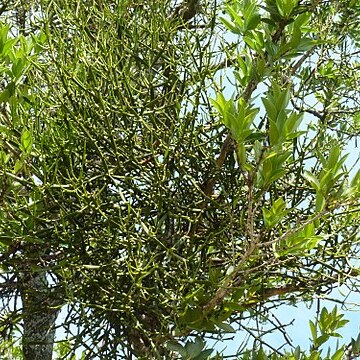Leafless, dioecious shrubs of relatively large size, 1-2 m high, often becoming pendulous with age, typically yellowish green; younger branches strongly flattened and ribbed; older branches rounded; basal inter-nodes of younger branches (20-)30-35(-40) x 4-6 mm. Staminate flowers in dichasia (occasionally 2-flowered), solitary in axils of scale leaves on younger branches, often in fascicles of 4-8 on older stems. Pistillate flowers solitary in the bracteal cups, borne singly in axils of scale leaves of younger branches, bracteal cups rounded and bilobed. Berries ellipsoid, 6-7 mm long, sessile, warty when young but nearly smooth and orange at maturity, apex truncated; style persistent. Flowering inconsistent, but possibly mostly from February-May, and perhaps scattered throughout the year.
Leafless, dioecious shrub, up to 2 m high; parasitic primarily on species of Combretum. Stems flattened, especially when young, older stems becoming rounded; internodes mostly 30-35 x 4-6 mm. Flowers: yellowish green; Jul.-Jun. Fruit sessile, ellipsoid, warty when young.
Leafless, dioecious shrub, up to 2 m high, parasitic primarily on species of Combretum. Stems flattened, especially when young, older stems becoming rounded. Internodes mostly 30-35 x 4-6 mm. Berries sessile, ellipsoid, warty when young. Flowers yellowish green.
Leafless, dioecious, shrubs of relatively large size, 1–3 m in extent, usually pendulous with age, often yellowish-green; internodes of distal branches 20–35 × 4–6 mm, flattened and strongly ribbed, rounded with age.
Staminate flowers in triads (occasionally dyads), sessile, solitary in the axils of scale leaves of younger branches, but often in fascicles of 4–8 on older stems.
Berries sessile, orange, 6–7 mm high, rotund-ellipsoid, tuberculate when young, but nearly smooth at maturity, apex truncated.
Style indistinct at maturity; stigma rounded, emerging directly from the slightly elevated summit of the ovary.
Ring scar left by perianth not strongly differentiated, 4–5 mm in diameter.
Bracteal cups and flowers of both sexes sessile.
Pistillate flowers borne singly.

